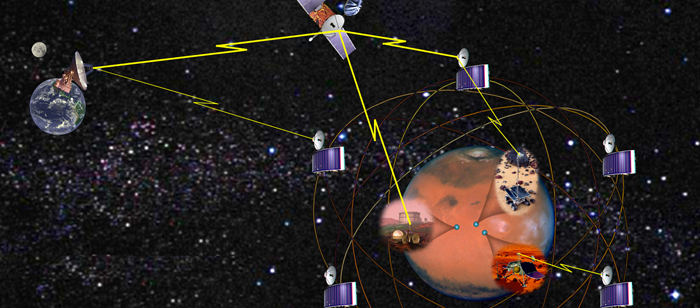
Ph.D. Dissertation Proposal
Virtual Circuit Provisioning in Challenged Sensor Internetworks,
with Application to the Solar System Internet
Ed Birrane
9:00am Friday, 21 September 2012, ITE 325b, UMBC
As sensing devices are applied to increasingly diverse tasks the network architectures that connect them must handle increasingly complex sets of operational constraints. One dimension in which these networks must scale is in their spatial footprint: there is a desire to distribute sensing devices over areas from miles to hundreds of miles to millions of miles. A second dimension in which these networks scale is in their media access heterogeneity: to gradually cover larger distances, existing networks (that may not otherwise communicate amongst themselves) must be stitched together. Examples of such networks include the Solar System Internet (SSI), Autonomous Underwater Surveillance (ASU), National Border Protection (NBP) and Intelligent Highway Initiatives (IHI).
I propose that the non-random sensing performed in these networks supports the establishment of virtual circuits that communicate information more efficiently than in broadcast mesh networks. Specifically, virtual circuits may be pre-negotiated using data-link-agnostic overlay techniques based on directed, weighted, time-variant graphs. The construction and maintenance of these circuits is feasible in non-random networks and may be accomplished through proposed protocols and stochastic processes. My first contribution will define an emerging, useful special case of networks. I label this architecture the "Challenged Sensor Internetwork" (CSI) and provide models relating to data motion and path selection. My second contribution will provide algorithms and associated analysis for path selection and synchronization. The network topology created by a CSI is graphically modeled as a multi-hypergraph. Since transmission in a CSI is wireless, a single transmission may be received by multiple nodes in the network, hence a hypergraph. However, as a challenged network, link opportunities amongst nodes will change as a function of time, hence a multigraph. I will show that the multi-cast problem, as formulated for CSIs, is NP-Complete, propose an approximation algorithm for the generation of paths in such a multi-hypergraph, and provide an analysis of the performance of this algorithm. My third contribution will provide heuristic algorithms and performance measurements. Each node in the CSI must store its own copy of the network graph so as to make local routing decisions. Synchronization of these network graphs across the network is often impossible. I propose two heuristic mechanisms, based on my proposed principle of path locality, to synchronize preferred path information in the network: exchanging relevant sub-graphs along paths as part of nominal messaging and altering local graphs based on predicted congestion based on observed traffic. Finally, I propose a method for inferring overlay-level contact opportunities from routing information available to local nodes via existing physical and data link layer mechanisms. My final contribution will demonstrate this work in the context of a real-world CSI deployment. I will provide a case study demonstrating how the SSI networking concept exemplifies the definition and characteristics of a CSI and showing how my proposed algorithms are mission enabling to existing, published SSI scenarios.
Several portions of the proposed dissertation work have been completed and validated through simulation and peer-reviewed publication. To complete the dissertation, I plan to finalize the problem statements, proofs, and algorithm analysis supporting achieved heuristic results. I will also apply these algorithms to scaled simulations and emulations of increasingly complex CSIs.
Committee: Drs. Dr. Mohammed Younis (Chair), Alan Sherman (Co-Advisor) Dhananjay Phatak, Vinton Cerf, Keith Scott, Hans Kruse